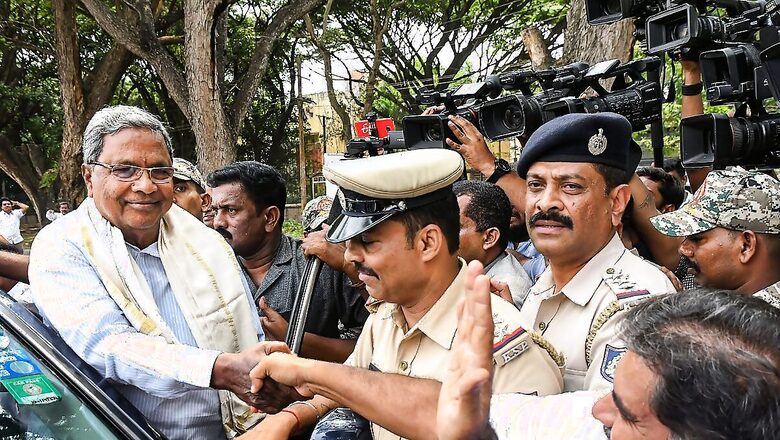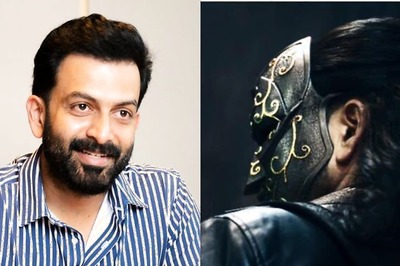
views
aap Standing atop the steps of the iconic and majestic Vidhan Soudha, which houses Karnataka’s state legislature, had once been the preferred choice for several chief ministers to take their oath of office until it turned out to be unlucky.
Built in 1952 by Kengal Hanumanthaiya, the chief minister of the then Mysore province, this imposing structure has been the pride of the state with its beautiful facade and 45 grand stairs at the entrance. However, fate had it that at least six Karnataka chief ministers who chose to hold their swearing-in ceremonies on the footsteps of this neo-Dravidian architectural marvel did not complete their full five-year terms.
Stairway to power(less)?
Political upheavals, defections, scandals, or political differences could have been among the many causes for governments to fall in Karnataka, but the Vidhan Soudha jinx continues to haunt those in power, and many take it quite seriously. In this southern state, a total of nine chief ministers have held office for less than a year, and more than half of the chief ministers have governed the state for less than two years continuously.
Today, as Siddaramaiah took over the reins of Karnataka as the 24th chief minister, his office once again chose to hold the ceremony at Kanteerva stadium, just as he did in 2013. Devaraj Urs, Karnataka’s first chief minister, and Siddarmaiah (2013) are the only two CMs to have completed full terms, and incidentally, neither of them held their oath-taking ceremonies on the steps of Vidhan Soudha. Urs took his oath at the Raj Bhavan, while Siddaramaiah did it at the Kanteerva stadium.
Although HD Kumaraswamy tried to break the jinx after extensive consultations with astrologers in 2018, unfortunately, he too lost power within 14 months of being sworn in as chief minister on the steps of the Vidhan Soudha.
Here is the list of chief ministers who were caught in the ‘jinx’:
Ramakrishna Hegde: Until 1983, the swearing-in ceremony of chief ministers in Karnataka was administered by the state governor at the Glass House located inside the Raj Bhavan. However, in 1983, Hegde decided to make it a grand event by holding the ceremony on the imposing steps of the Vidhan Soudha. Hegde had created history by being the first leader from a non-Congress party to become chief minister. He wanted his swearing-in ceremony to be a grand affair and opened it to the public, so the people of Karnataka could also witness it live as they gathered around the magnificent seat of power, which even today is considered an architectural marvel.
Hegde’s tenure as chief minister was marred by controversies and he had to resign before completing a year in office. The Karnataka High Court criticised his government’s handling of arrack bottling contracts, which ultimately forced him to resign. However, he withdrew his resignation after three days, only to face another serious charge of phone tapping prominent politicians and businessmen, leading him to eventually resign towards the end of his tenure. Hegde was succeeded by SR Bommai.
Karnataka was later under President’s Rule twice between April 1989 and October 1990. Veerendra Patil was made CM briefly (less than a year), but the ailing CM was asked to step down by Rajiv Gandhi, the then Prime Minister of India.
S Bangarappa: Sarekoppa Bangarappa took over as Karnataka’s 12th chief minister in 1990 after Patil’s tenure, and just like Hegde, he chose the steps of Vidhan Soudha for his oath-taking ceremony. Sadly, Bangarappa’s tenure did not last a full term. His time as CM had been tarnished by numerous accusations linking him to various scandals, notably the Classik Computers controversy, of which he was eventually exonerated. However, two years into his term, Bangarappa was replaced by Veerappa Moily after his administration failed to effectively address the Cauvery water agitation issue, which led to widespread protests and riots across the state.
Such was the effect of the “jinx” that subsequent chief ministers HD Deve Gowda and JH Patel refused to take oath on the “cursed” steps, fearing they would lose power.
SM Krishna: Nine years later, just when it seemed that the “jinx” was finally broken by SM Krishna, who also took his oath on the steps as Karnataka’s 16th chief minister, he dissolved the assembly just months before completing his five-year term in 2004. Krishna, while not explicitly pointing fingers at the then Vajpayee government, indirectly attributed the early assembly elections in the state to the Centre’s decision to hold early Lok Sabha polls. However, the Congress party suffered a significant setback in the subsequent assembly polls.
Dharam Singh: Dharam Singh became chief minister after the Congress formed an alliance with the JDS, and he too took his oath on these steps. Singh remained CM for close to two years, and the alliance finally came to an end in 2006 after HD Kumaraswamy (JDS) rebelled to join hands with the BJP.
HD Kumaraswamy: In a 20-month-20-month formula, Kumaraswamy (JDS) and BS Yediyurappa (BJP) took oath as chief minister and deputy chief minister on the steps of Vidhan Soudha in 2007. Not only did the alliance collapse in 20 months, but Yediyurappa, who took oath as BJP’s first chief minister in south India, was forced to resign within seven days after the JDS withdrew support.
BS Yediyurappa: Nothing could stop Yediyurappa from single-handedly opening BJP’s account in a southern state after it was elected as the single-largest party with 110 seats. The BJP aligned with six independents, and Yediyurappa took the risk of taking his oath as CM on the steps of Vidhan Soudha. He was the first CM to take an oath in the name of the farmers of Karnataka, but the leader had to step down after he was arrested by the Lokayukta in the multi-crore illegal mining scam. Sadanand Gowda and Jagdish Shettar succeeded Yediyurappa to complete the BJP’s five-year term in governance.
Siddaramaiah skipped the steps
The Congress managed to come to power with a thumping majority in 2013, with Siddaramaiah as its CM. The self-proclaimed “atheist,” however, decided to skip the steps and hold the ceremony at the Kanteerva stadium, with thousands of people, party workers, and leaders in attendance.
Kumaraswamy jinxed again
In the following assembly polls held in 2018, the BJP, despite being the single-largest party with 104 seats, could not gather enough support to cross the halfway mark (113 seats) in the 224-member strong Karnataka assembly. Sensing a perfect opportunity, the Congress and JDS aligned to form a coalition and came to power with HD Kumaraswamy at the helm.
Kumaraswamy organised a grand ceremony at Vidhana Soudha where he took oath as the chief minister. It was learned that the “jinx” factor was certainly on Kumaraswamy’s mind, especially as the leader is known to be extremely superstitious. In fact, Kumaraswamy is said to have consulted several astrologers and conducted a special pooja before taking his oath on the steps of the Vidhana Soudha. He even arrived at the exact time, 4.30pm, for the ceremony, as advised by astrologers.
The tenure of the coalition was turbulent, and it came to an end exactly 14 months after it assumed office. The government lost the trust vote (99-105) moved by Kumaraswamy, bringing the curtains down on the coalition and paving the way for the BJP to form its government once again under BS Yediyurappa.
Fate sealed
A careful Yediyurappa stayed clear of the steps of Vidhan Soudha, but that did not stop the fact that he quit as chief minister after the BJP high command asked him to step down. He announced his resignation on the exact same day that he completed two years as the chief minister. He was succeeded by Basavaraj Bommai, who took his oath of office at the Raj Bhavan.
Etched in stone?
This time around, Siddaramaiah too has tried to steer clear of the jinx as he takes over as chief minister for the second time. If he completes his full five-year term, he will set a record as the only chief minister in Karnataka to do so. So why would he let a jinx ruin his only chance to etch his name in the history of Karnataka?




















Comments
0 comment